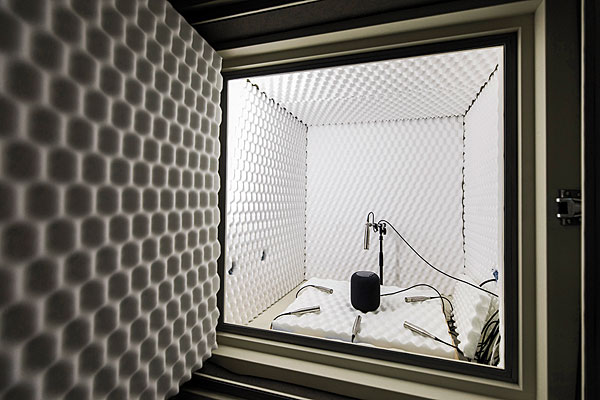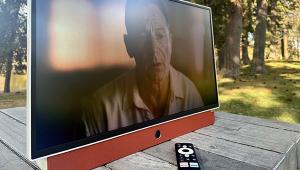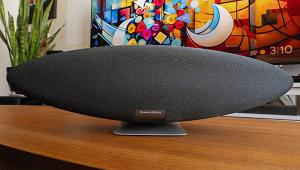Thanks for the insightful review! Would you mind letting us know what firmware was used in the Homepod tested? The new updated 11.3 supposedly makes the Homepod more balanced by letting the mids and highs not be as overwhelmed by the bass. I'm a fan of this. However, there are a lot of people who enjoy the promient bass and there are talks of Apple changhing it back with the release of 11.4. Thanks!
Apple HomePod Wireless Smart Speaker Review

AT A GLANCE
Plus
Superb sonics with extraordinary bass
Great build quality
AirPlay capable
Easy setup
Minus
Integrated music streaming restricted to Apple Music
No bluetooth
More limited smarts versus competition
No wired input for TV viewing
THE VERDICT
Apple has created the best-sounding small speaker we’ve heard to date, but its Apple-centricity and immaturity as a smart device may deter some buyers.
From conception through launch, the Apple HomePod speaker was six years in development. That’s a long time to bring to fruition something as ubiquitous and seemingly simplistic as a wireless tabletop speaker. If we account for the many poor examples of the breed, we can acknowledge that a truly excellent wireless speaker might require some extra time to create...but six years? The HomePod was so long in coming that the “smart speaker” with builtin voice assistant that it eventually became hadn’t yet been invented (by rival Amazon) when the project was begun. Which, I’m certain, delayed it even further.
This lengthy R&D, however, is why you’ll hear Apple promoting the HomePod, first and foremost, as an extraordinary audio product—because that’s what it was conceived to be: a small wireless speaker like none that had come before. And the bar was already high. Even six years ago, Apple knew how to make an excellent, if more conventional, tabletop speaker. The boombox-sized and short-lived iPod HiFi, launched in 2006, was an extraordinary product for the time, costing the same as the HomePod today ($349, then an exorbitant price tag) and delivering critically acclaimed sound quality that lived up to its name.
With HomePod, Apple again sought to invent a remarkable lifestyle speaker, this time in the more compact size essential to our times, and in so doing largely reimagined what could be done with the tabletop category. Inside Apple, HomePod is considered so significant an achievement and the message of its sound quality so important that the firm uncharacteristically invited press to tour its previously shrouded audio lab before the launch—to communicate the resources and expertise brought to bear on the project. These were indeed impressive, and I’ve been to a few speaker labs in my day. I stood wide-eyed in the largest anechoic chamber I’ve seen, as well as a variety of other acoustic measurement spaces developed specifically for this project.

The speaker product that emerged from all of this is a stout little cylinder standing 6.8 inches tall and 5.6 inches wide, with rounded top and bottom edges. It weighs a substantial 5.5 pounds and rests atop a round, silicone isolation foot that made for a bit of bad press when it was quickly found to leave white marks on some wood furniture finishes, sometimes in as little as a half hour. Apple acknowledged the issue and said the marks fade over time or can sometimes be removed with furniture cleaner. (I had no such issues resting HomePod on my dark-wood desk for lengthy periods, but be forewarned. I’m sure matching HomePod doilies for those with fine furniture won’t be far off.) The acoustically transparent fabric mesh grille around the speaker has a foam-like underlay, so the speaker offers a kind of squishy, tactile feedback when you grasp it that almost makes it huggable. There are no connectors of any kind, just a supple, nicely braided non-removable power cord. Overall build quality and fit-and-finish are outstanding. The speaker comes in two colors: white, with a matching highgloss top panel, and the Space Gray featured on my review sample, with a black gloss top.
With no hard-wired connections, you get content into HomePod solely via your Wi-Fi network, from which it can play files from an iTunes music library in Apple’s iCloud, an Apple TV streamer on the same network, the Apple Music streaming service—a $9.95/month add-on—or via AirPlay from your iPhone or other AirPlay-compliant source.

Let me emphasize a critical point: Beyond Apple Music, you cannot use Siri voice commands to call up music or programming from any of your other favorite music services on the HomePod—no Spotify, Tidal, Pandora, iHeart Radio, TuneIn, et al. You can still boot each service’s app on your iPhone, iPad, or Mac and AirPlay them over to HomePod, but aside from play, pause, and volume there’s no Siri control, so you can’t use voice to request artists, songs, or playlists. (However, you can ask Siri to tell you what’s playing or about the artist while listening to thirdparty services.)
Given that the research says music listening is the number-one thing folks are doing with these smart speakers, that pretty much locks you into an additional $10/month subscription with Apple Music if you’re not already using that service. Outside of Apple Music, Siri does support podcast bulletins from a number of news services including NPR, CNN, Fox, NBC, ESPN, and some others. I was also able to call up a live stream of WNYC, my local NPR station, but not of CNN (which TuneIn would support were it available here).
This Apple-centric approach—without even a universal Bluetooth option and with the requirement of the Apple Home app to set the speaker up—isolates the HomePod market to iOS and Mac users. No surprise there. But the lack of any wired analog or optical input also precludes the speaker’s use for day-to-day television viewing, though it is said you can (somewhat inconveniently) port video sound from an Apple TV to the HomePod. I didn’t have an Apple TV around to try it and check for lip-sync issues.
The top panel has integrated touch controls with LED indicators beneath it. When the speaker is idle, the panel is totally opaque. Activate Siri with the “Hey, Siri” wakeup call, and a smoky, bottle-cap-sized blob of swirling rainbow colors appears in the center and pulses to your voice and to Siri’s response. While music or other programming is playing, “+” and “–” icons appear, which can be tapped or held for manual control of volume. (You can also ask Siri to simply raise or lower the volume, or to set the level to a number from 0 to 100, with or without the word “percent.”) A touch-and-hold anywhere on the panel brings up Siri to await your command. You can tap once anywhere on the touchpanel to pause or play your selection, double-tap to skip ahead a track, or triple-tap to skip back. Two key HomePod benefits have been promised for later this year via firmware updates. Multiroom audio, including the ability to direct different streams to different rooms, is awaiting Apple’s delayed rollout of AirPlay 2. Likewise, the ability to do stereo pairing with two HomePods is also on the way.
Inside HomePod
Stacked up inside the HomePod’s cylindrical casing is a totem pole of cutting-edge technology run by sophisticated software, all intended to squeeze the absolute biggest sound possible from what is admittedly a very small package. Starting at the top is that touchpanel and the powerful Apple A8 processing chip used to power both the audio signal management and the speaker’s smart functions. This is the same processor Apple uses in its iPhone 6 phones. Directly below this is a 4-inch upfiring high-excursion woofer designed just for the HomePod; the paper cone offers 22mm (0.87 inches) of peak-to-peak movement, extraordinary for such a small driver. Its output is monitored by a dedicated microphone; more on this shortly.

Below the woofer, on a supporting structure, is a band of six far-field microphones mounted in a full 360-degree pattern around the speaker. These mics are used for both Siri voice control and for room correction, about which I’ll also say more in a moment. Below the mics, near the base of the unit, is a circle of seven 1-inch aluminum dome tweeters, each driven by its own dedicated Class D amplifier and mounted to its own folded-horn waveguide to help control directionality of the sound. The end result, once processing is applied, is that the speaker has something akin to an omnidirectional radiation pattern.
The HomePod uses all this stuff to give itself what Apple calls “spatial awareness.” Within a few seconds of playing the speaker from any new location, the circumference microphones have fed signals back to the A8 chip so it can detect reflections and establish the distance to room boundaries. Based on this, the speaker knows, for example, if there’s a wall behind it or a pair of walls in the guise of a corner, and how far away it is.
It then uses the individually addressable tweeters to create three directional “beams” of sound: one emanating out of what it has deemed the front of the speaker and a pair fanning out toward the rear of the speaker. Although the HomePod is a mono speaker, the processor monitors both channels of the incoming stereo signal to determine what should be heard directly from the front and what constitutes ambient information that is best bounced off the back walls to create a more spacious and open sound. Move the speaker by even an inch, and its built-in accelerometer will detect the motion and recalibrate. Meanwhile, the woofer’s dedicated microphone is correlating the cone’s output with what’s coming back from the room mics and issuing corrections to achieve maximum bass with minimum distortion. Compare the ease of this transparent process with the (albeit very effective) Trueplay sequence used to room-correct a Sonos speaker, which takes about three minutes and requires you to walk around the room with your phone while it listens to tones from the speaker.
The A8 processor, as if it didn’t already have enough to do, is also listening at all times for the “Hey, Siri” wakeup words and applying echo cancellation and other sophisticated processing to allow you to be heard from extraordinary distances for a product like this and over the sound of potentially loud music. I tested this function with the speaker situated on my desk in my basement office while playing hip-hop at 75 percent volume. After stepping through an open doorway to the rear of my listening studio, 25 feet away, I barely had to raise my voice to get Siri to respond to the wakeup call. Anything closer required nothing more than a normal speaking voice to get her attention through the rap lyrics.
Setup
After jumping through an almost laughable number of screens and steps a while back to introduce an Alexa-enabled Sonos One to my system (review at soundandvision.com), setting up the HomePod was a breath of fresh air. It was done before I knew it. First, you boot up the Apple Home app on your iPhone or iPad and power up the speaker by plugging it into the nearest wall outlet. The app detects the signal via a dedicated nearfield setup-only Bluetooth connection, picks up the Wi-Fi network information from the phone, then quickly steps you through just four additional screens to (1) select a room name; (2) enable Personal Requests; (3) transfer over your iTunes, iCloud Music Library, and existing Apple Music settings from your phone; and (4) activate a free trial on Apple Music if you’re not already subscribed.
And that’s it. You’re done and ready to ask Siri to fire up some tunes or feed you the weather. Of particular note is that second setup screen to enable Personal Requests. Assuming you’re the individual whose iPhone was used to set up the speaker, enabling Personal Requests lets you send texts via the HomePod or to listen to Siri read your recent texts—a nice convenience. However, as reported elsewhere, the HomePod does not recognize individual voices and thus allows anyone near it to request a read of your recently received messages, or to send a text in your guise to anyone at all. All that’s required is that you have your phone currently connected to the same Wi-Fi network. That may not be an issue if you live alone, but if you’ve got kids or a visitor intent on mischief or worse while you’re elsewhere in the house, it could spell trouble. If this is a concern, you can either choose not to enable Personal Requests during setup or disable it at any time in the Home app. Doing so will also prevent you from using the HomePod to set up reminders on your phone.
- Log in or register to post comments





















































